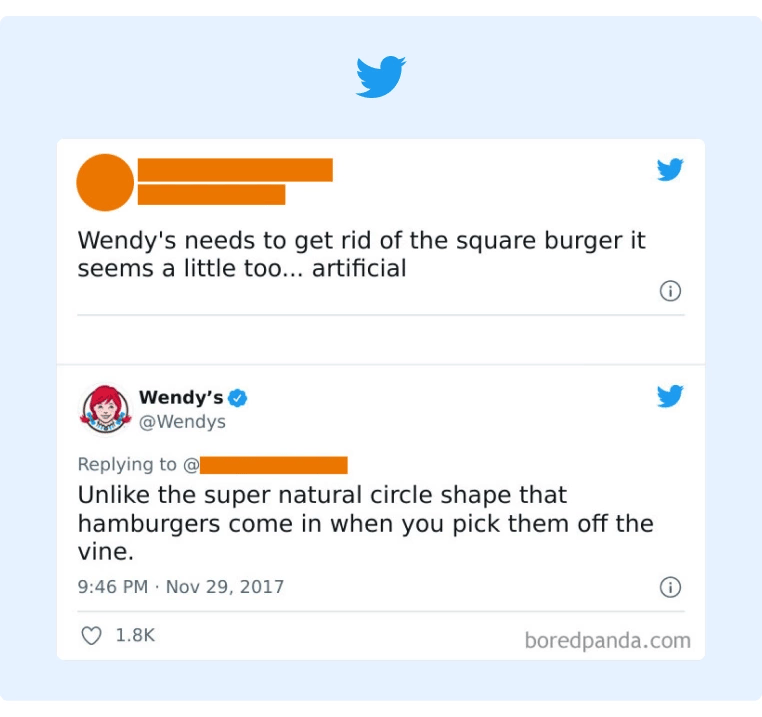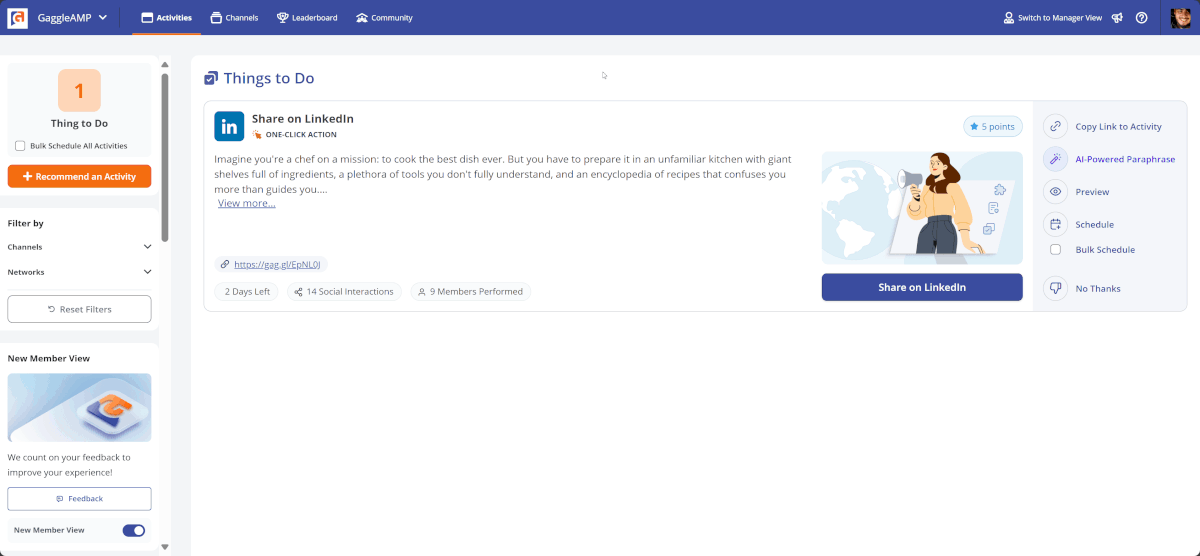Social Media Messaging: Build Trust Through Consistent Communication
From building customer relationships to increasing brand awareness, social media gives businesses a platform for endless opportunities to grow their brands and connect with their audiences.
But in recent years, social media platforms have become crowded spaces. In fact, 92% of US marketers use social media for marketing purposes, making it tough for brands to stand out.
Clearly, having a social media presence is no longer enough. And that’s not the only problem facing marketers. More than 70% of customers say they desire conversational experiences during brand interactions, too.
So, how can you make your brand stand out on social media while providing that personalized customer service your customers need?
Create an effective social media messaging strategy!
If you’re looking for a complete guide to social media messaging and are eager to know the most popular social media messaging apps (for interacting with customers), you’re in the right place. Let’s get started!
What Is Social Media Messaging?
Social media messaging is the way you communicate with your audience on social platforms.
There are two main factors to consider when creating a social media messaging strategy. The first is determining how you want to communicate your brand’s values and voice with your target audience. The second is identifying which social media channels to use. Both should align with your broader marketing communication strategy.
If you use multiple social media platforms, your social media messaging will vary. For example, TikTok’s audience expects informal and short messaging. On the other hand, LinkedIn is a professional platform where its audience gravitates toward long-form content.
Regardless of which social media platform you are using, while the messaging style may differ, the brand’s values and goals must stay consistent.
What Are the Benefits of Using Social Media Messaging Apps?
Social messaging is a game changer in how businesses can engage and connect with their target audience. From providing rapid responses to questions, to personalized shopping experiences, and even mitigating the occasional public relations crisis, there are many benefits to using social media messaging apps.
Here are three ways social media messaging can help your brand.
1. Provide Unparalleled Convenience
Think of the last time you had to contact a brand to fix a broken appliance. Chances are you called a toll-free number and were left on hold for what seemed like an eternity before you were finally connected to a customer service representative. Such experiences rarely leave customers with a good impression of the brand.
On the other hand, if you could reach out to a customer care representative via a social media messaging application you’re familiar with, you could resolve your issue in minutes. You can share photos or videos of the faulty part so the representative can understand the problem.

Source: Instagram Direct Marketing: Everything you need to know!
Social media messaging makes it easier for individuals to connect with brands and helps create positive customer experiences. They help meet the core demands of modern consumers — speed, convenience, friendliness, and knowledge of customer service.
2. Personalize Customer Interactions
Social media messaging applications can help you give shoppers a customized experience at scale. This is possible through the use of chatbots. Chatbots simulate a conversation or interaction with a real person, either as a web-based application or a standalone app.
Many social media messaging services allow you to set up fixed responses for commonly asked questions. For example, if you own a footwear brand, you can set up automated responses for queries like where is your store located, how is your footwear priced, and what sizes you offer. The chatbot can use the customer’s data from previous interactions to address them by name and give them local store information.
However, it’s important to remember that chatbots cannot answer all questions, and human agents may sometimes be required.
3. Manage PR Crises
It’s important to monitor comments on your social media handles and respond to both positive and negative feedback. There will be days when a customer is unhappy with your brand. But how you respond to the situation will determine the impact on your brand reputation.
That's not the experience we want you to have. DM your record locator and we'll take a look.
— americanair (@AmericanAir) February 27, 2023
If a customer expresses they had a bad experience, try to move the conversation into a private direct message rather than asking for more details on a public platform. This will help you resolve the issue quietly without alerting your other followers and potentially creating a full-blown public relations nightmare.
What Are the Main Challenges of Social Media Messaging?
It can be challenging to create an effective social media messaging strategy. Here are three common issues marketers face when developing a social media messaging plan and how you can solve them.

1. Keeping Messaging Consistent
Whether it’s a chatbot or a human customer service representative, you want the messaging to be consistent – the same language, tone, and style (formal or informal).
A good practice is to create a customer service messaging guide that team members can refer to when they’re not sure how to respond to a particular question. Include as many details (and common scenarios) in the handbook as possible.
For example, if emojis are permitted, include which ones the representative can use. You can also hold regular training sessions for customer-facing employees to ensure brand standards are met in all online and offline communications.
2. Creating Channel-Wise Content
Chances are your business has more than one social messaging platform, and creating unique content for each platform can be time consuming. While it may be tempting to copy and paste the same content from, say, LinkedIn to Twitter, it may not give you the best results. Here’s why: LinkedIn content is more formal and longer than Twitter’s shorter, more informal tweets.
However, this doesn’t mean you can’t use the same content for your social media platforms; it just needs to be optimized for each specific social platform.
For example, to optimize your LinkedIn content for Twitter, this means you’ll want to decrease the word count, make the language less formal, and add relevant hashtags.
3. Making Your Messaging Stand Out
When there’s a lot of digital noise, creating content that stands out can be difficult. Being authentic to your brand values can go a long way in creating memorable, unique, and effective content.
While you can seek inspiration from other well-performing campaigns or trending content ideas, you should not copy them blindly. Instead, put your spin on the idea to help distinguish your brand from your competitors.
For example, you can use humor as part of your messaging (if it makes sense for your brand). Here’s an example of a brand that is well-known for driving audiences through its social media messaging.

Source: Boredpanda
Like any other marketing strategy, social media messaging requires some trial and error to get it right. You can use data metrics such as engagement rate, reach, the volume of comments, and the number of followers to measure your performance and see if you’re on the right track.
Apart from quantitative metrics, you can also look at qualitative results, such as the general sentiment of the comments being posted.
The Top Social Media Messaging Apps
80% of customer service organizations will replace native mobile apps with messaging platforms by 2025. According to Philip Jenkins, senior direct analyst in the Gartner Customer Service & Support practice, messaging platforms will help businesses, “...reduce dependency on native mobile app experiences, reduce cost, increase digital and self-service effectiveness, and achieve a persistent experience for customer engagement.”

Ready to get on board the social media messaging wagon? Here’s our list of the top eight social media messaging apps. Consider using the ones that make the most sense for your brand’s target audience.
1. WhatsApp
With approximately two billion monthly global active users, WhatsApp is the most popular messaging app in the world.
WhatsApp allows you to communicate with customers through chat, audio calls, or video calls. You can also send images, videos, voice recordings, and other file formats (such as PDFs and GIFs) with information about your products and services. And if you receive many messages each day, you should consider getting WhatsApp Business and using a WhatsApp chatbot.
WhatsApp is a cost-effective alternative to traditional texting, especially if you have a global audience since you don’t have to pay to send internal messages. Moreover, there is no character count limit on each message.
2. Messenger
Originally released as Facebook Chat in 2008, Messenger now serves as Meta’s proprietary instant messaging app. It is one of the most powerful tools marketers can use to craft a great customer experience. Since the Messenger app is linked to users’ Facebook profiles, it allows you to reach out to the platform’s nearly three billion monthly active users.
A standout feature of Facebook Messenger is the ability to integrate ads into chats. Meta offers Click-to-Messenger ads where the call to action (CTA) of a sponsored post can prompt the user to send a private message to the brand. This further drives engagement and sales by making it easy for potential customers to resolve any questions that they may have about the products or services.

Source: MobileMonkey
Meta also allows you to build customized bots on Workplace. These bots can interact with your customers by answering commonly asked questions and by posting new content and commenting on content with new information.
3. Instagram Direct
Over 200 million businesses use Instagram to market their offerings and connect with current and potential customers. Having an updated and active Instagram business profile can boost sales, with 72% of shoppers using the platform to make their next purchase decision.
Instagram Direct offers marketers many features to provide customers with an enhanced shopping experience. Besides regular text-based conversations, brand reps can connect with shoppers over video or audio calls to help answer questions. Instagram Direct also supports group calls, making it easier for multiple team members to join a call.
Moreover, when a customer tags you in their story, you will receive a notification in your chat thread with them. This makes it easy to keep track of all interactions in a single place.
4. WeChat
WeChat is a free messaging and calling app that is available on MacOS, Windows, Android, and iOS. While the social media and messaging platform was initially only popular in China, the international app now has over 1.31 billion monthly active users.
The app also lets you call landlines and mobile phone numbers, giving you the potential to reach an even larger audience. The app also has an efficient barcode scanner feature which allows users to quickly scan other users’ personalized codes and add them as contacts to their database.
WeChat also provides excellent social commerce integration such as WeChat Pay, which allows users to make purchases without exiting the app.
5. TikTok Direct Messages
TikTok is gaining in popularity with social media marketers. In 2022, 24% of marketers considered TikTok effective for reaching their business goals. The previous year (2021) that statistic was just 3%!
It’s important to note that TikTok recently modified its DM settings, giving users the ability to choose who they want to receive messages from. The options now include:
-
Everyone.
-
Suggested friends.
-
Mutual followers.
-
People you’ve sent messages to.
-
No one.
If a user selects “everyone” this will make it easier for brands to connect with that user (if they’re in their target audience). Before these newly implemented direct messaging settings, only people who users had identified as “friends” or were “recommended” could DM each other on TikTok.
An added feature that makes TikTok appealing to brands is the ability to set up automated keyword responses for business accounts. This makes it more efficient to respond to frequently asked questions and provide basic information about the brand, such as working hours and the link to your e-commerce website.
6. Telegram
Telegram is a cloud-based messaging app known for providing unparalleled security to its users. Business users and small teams can benefit from the app’s various features such as creating large groups of up to 200,000 members and sending self-destructing messages, photos, and videos to protect sensitive data.
Markets can use Telegram Pods to amplify their reach on other social platforms like Facebook and Instagram. Telegram Pods are communities consisting of people who are passionate about a specific brand. So, when you share important posts and updates for your brand in the pod, the members will likely engage with and share the content, increasing its visibility.
7. Twitter Direct Messages
If your brand has a Twitter profile, chances are you’re also using direct messages (DMs) to speak with your audience. Like the platform, Twitter DMs are designed for rapid communication and information sharing.
In 2022, Twitter had 229 million daily active users, making the app a valuable tool (if it’s relevant for your target audience). Twitter’s layout makes it easy for businesses and customers to have a conversation.
Suppose a customer sends you a message asking how to fix a convection oven they purchased from your store. Rather than breaking the conversation into multiple, scattered messages, you can consolidate the communication into a single thread, making it easy for both parties to refer back to it.
8. Kik
If your target audience consists of Gen Z and Millennials, you should consider using Kik. It is a Canadian-based social media messaging app where users set up usernames to communicate with each other.

Source: TechJunkie
The app’s features include one-on-one chatting and the ability to create groups of up to 50 users. Plus users have the ability to send emojis, GIFs, and stickers, which appeal to Millennials and Gen Z.
Upgrade Your Social Media Messaging Efforts With GaggleAMP
If you’re looking to meaningfully engage your audience and get the best ROI on your marketing, social media messaging should be a priority for your business. Customers are more likely to give you their business when they feel valued and your social media messaging strategy can go a long way in giving them an enhanced customer service and shopping experience.
You can use an employee advocacy platform like GaggleAMP to take your social media messaging efforts one step further. GaggleAMP makes it simple and convenient to collect, curate, and distribute employee and user-generated content from marketing campaigns and employees.
Simply serve employees content for them to share or interact with, all from within our easy-to-use platform. This then engages their audience with meaningful content, growing your brands visibility and their credibility in your industry.

Request a demo to discover how employee advocacy with GaggleAMP can help boost reach and engagement for brands and organizations of all sizes and industries.












